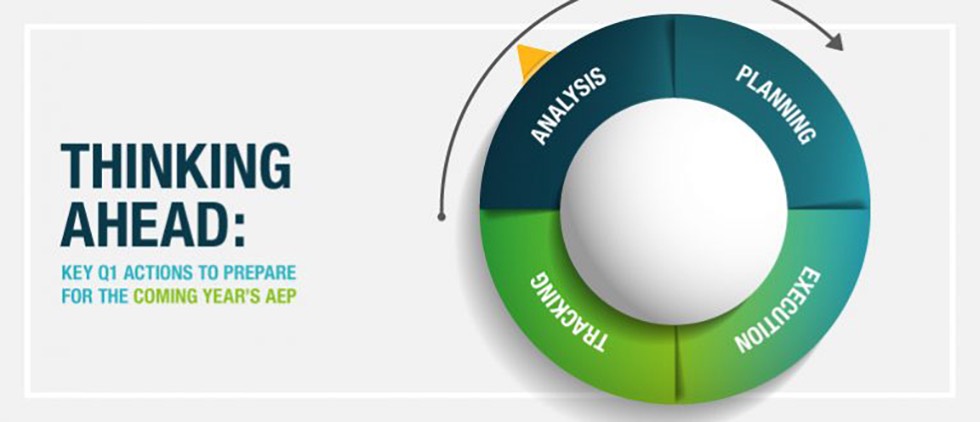Thinking Ahead: Key Q1 Actions to Prepare for the Coming Year’s AEP

The Medicare open enrollment period (or AEP) is officially over. Now what? Data is being processed. Results are being tallied. It’s time to start it all over again. To put it simply: the ANALYSIS ➡ PLANNING ➡ EXECUTION ➡ TRACKING process starts anew. Here are some tips to help keep things moving in the right direction and build momentum as the new AEP season approaches.
Get Marketing and Sales on the same page.
While the AEP is still fresh in everyone’s mind, connect with Sales on the broad picture. Look at different lines of business and key audiences and stakeholders. Solicit and document their advice for the coming year’s AEP. Consider using the applicable questions below to guide the conversation:
- What information did leads perceive as critical to their decision making process? Was this information available to prospects and in a timely manner?
- What were the most common questions that were asked?
- What were the primary reasons that leads converted to sales?
- What were the primary reasons that leads were lost?
- Did your brokers feel properly supported?
- What did you hear from brokers about how your plan stacked up against the competition?
- What did you learn from your experiences trying to sell-in to groups?
If after the audit, there are still gaps in understanding the consumer (or brokers or groups), think about what primary research could be conducted to help fill those gaps. Start planning that research now so that the results can help inform the planning process. Determine if there are any marketing or communication tools that Sales would have found useful during the AEP. Finally, take this opportunity to reflect on the Sales-Marketing relationship and communication process. If it needs improvement, define communications goals and outline key steps to reach those goals during the upcoming AEP.
Immerse yourself in the campaign performance data.
It can be perilous to make decisions based on response data alone, so before analyzing your data, take a good, hard look at the type of data you’re collecting. More informed decisions can be made when marketers can attribute lead generation to individual tactics. With the right data in hand, buckets tactics into one of four groups based on lead generation:
- High volume, delivered efficiently – Can more budget be spent on those tactics next year without diminishing returns?
- High volume, delivered inefficiently – Can formats be altered or targeting refined? Where can you reduce costs while maintaining the effectiveness of the tactic? Is there a soft spot somewhere in the conversion funnel?
- Low volume, delivered efficiently – Would spending more against these tactics increase the volume without negatively impacting efficiency?
- Low volume, delivered inefficiently – Is there any reason to continue spending money against these tactics next year?
If the needed data isn’t available, look at broad budget implications: Were buys placed early enough? Did market conditions – like elections and holidays – create noise or disruption? Were there inventory issues that drove prices up?
Once you’ve answered these questions, start determining how best to fix tracking for next year’s campaign. Think through each of the response channels – phone, web, BRC. Establish which resources and systems need to be tapped to ensure the proper tracking and reporting mechanisms are in place.
Consider how your organization defines success.
Now is a great time to consider how your organization defines and calculates ROI. Acknowledge how these questions play a role in your organization’s definition of success:
- What is the average gross margin for each new Medicare member?
- What is the average net margin for each new Medicare member?
- What is the average tenure of your Medicare members?
- What is the net present value of each new member and how does it compare to the cost-per-acquisition?
During this period, find ways to prioritize marketing efforts and dollars – by market, segment and tactic. Additionally, make sure your organization understands why proper tracking and reporting mechanisms are vital to documenting ROI.
Armed with consumer insights, historical campaign data and a more profound understanding of the economic impact of each new member, this coming year’s AEP planning process will likely be more productive. Check back next quarter when we’ll outline a few more key planning steps healthcare marketers should focus on to ensure a successful AEP season. Want to talk about your upcoming AEP campaign? Drop us a line.









